Abstract
Purpose
To compare the anti-pseudomonal effect of nephrite-containing contact lens (CL) storage cases with conventional CL storage cases.
Methods
The degree of proliferation and adhesion of Pseudomonas aeruginosa (P. aeruginosa) on 1st–3rd generation silicone hydrogel contact lenses (SHCLs) was compared by using both 5% nephrite-containing CL storage cases and conventional CL storage cases. The degree of adhesion of P. aeruginosa to the CL was also compared in 1% or 5% nephrite solution and multipurpose solution (MPS).
Results
Nephrite-containing CL storage cases showed a significant inhibitory effect on P. aeruginosa proliferation (p = 0.03) and significantly reduced the number of adherent P. aeruginosa on all 1st–3rd generation SHCLs compared with conventional CL storage cases (p = 0.02, p = 0.03, and p < 0.01, respectively). There was no significant anti-pseudomonal effect of 1% and 5% nephrite solutions compared with MPS.
Go to : 
References
1. Buehler PO, Schein OD, Stamler JF, et al. The increased risk of abdominalative keratitis among disposable soft contact lens users. Arch Ophthalmol. 1992; 110:1555–8.
2. Poggio EC, Glynn RJ, Schein OD, et al. The incidence of ulcerative keratitis among users of daily-wear and extended wear soft contact lenses. N Engl J Med. 1989; 321:779–83.
3. Hahn YH, Hahn TW, Choi SH, et al. Epidemiology of infectious Keratitis[I] A abdominal study. J Korean Ophthalmol Soc. 1998; 39:1633–51.
4. Duran JA, Refojo MF, Gipson IK, Kenyon KR. Pseudomonas attachment to new hydrogel contact lenses. Arch Ophthalmol. 1987; 105:106–9.

5. Sy A, Srinivasan M, Mascarenhas J, et al. Pseudomonas abdominal keratitis: outcomes and response to corticosteroid treatment. Invest Ophthalmol Vis Sci. 2012; 53:267–72.
6. Vazirani J, Wurity S, Ali MH. Multidrug-resistant pseudomonas aeruginosa keratitis: risk factors, clinical characteristics, and outcomes. Ophthalmology. 2015; 122:2110–4.
7. Kang JS, Koo JY, Shyn KH. Three cases of pseudomonas corneal ulcer in wearer soft contact lens. J Korean Ophthalmol Soc. 1985; 26:761–7.
8. Jeon SK, Tchah HW. Pseudomonas keratitis due to mishandling of soft contact lenses. J Korean Ophthalmol Soc. 1996; 37:901–7.
9. Donzis PB, Mondino BJ, Weissman BA. Microbial contamination of contact lens care systems. Am J Ophthalmol. 1987; 104:325–33.

10. Bailey CS. A review of relative risks associated with four types of contact lenses. Cornea. 1990; 9(Suppl 1):S559–61. discussion S62–3.

11. Wilson LA, Sawant AD, Simmons RB, Ahearn DG. Microbial abdominal of contact lens storage cases and solutions. Am J Ophthalmol. 1990; 110:193–8.
12. Amos CF, George MD. Clinical and laboratory testing of a silver-im-pregnated lens case. Cont Lens Anterior Eye. 2006; 29:247–55.

13. Vermeltfoort PB, Hooymans JM, Busscher HJ, van der Mei HC. Bacterial transmission from lens storage cases to contact abdominal-Effects of lens care solutions and silver impregnation of cases. J Biomed Mater Res B Appl Biomater. 2008; 87:237–43.
14. Scheuer C, Zhao F, Erb T, Orsborn G. Multipurpose solutions and rates of biocidal efficacy. Eye Contact Lens. 2009; 35:88–91.

15. Jung JW, Lee JH, Park SH, et al. Amoebicidal effect of neph-rite-containing contact lens storage case. J Korean Ophthalmol Soc. 2017; 58:509–15.

16. Schein OD, Poggio EC. Ulcerative keratitis in contact lens wearers. Incidence and risk factors. Cornea. 1990; 9(Suppl 1):555–8. discussion S62–3.

17. Asbell P, Stenson S. Ulcerative keratitis. Survey of 30 years' abdominal experience. Arch Ophthalmol. 1982; 100:77–80.
18. Bruce AS, Brennan NA. Corneal pathophysiology with contact lens wear. Surv Ophthalmol. 1990; 35:25–58.

19. Teichroeb JH, Forrest JA, Ngai V, et al. Imaging protein deposits on contact lens materials. Optom Vis Sci. 2008; 85:1151–64.

20. Giraldez MJ, Serra C, Lira M, et al. Soft contact lens surface profile by atomic force microscopy. Optom Vis Sci. 2010; 87:E475–81.

21. Shayani Rad M, Khameneh B, Sabeti Z, et al. Antibacterial activity of silver nanoparticle-loaded soft contact lens materials: the effect of monomer composition. Curr Eye Res. 2016; 41:1286–93.

22. Stapleton F, Dart JK, Seal DV, Matheson M. Epidemiology of Pseudomonas aeruginosa keratitis in contact lens wearers. Epidemiol Infect. 1995; 114:395–402.
23. Donzis PB, Mondino BJ, Weissman BA, Bruckner DA. Microbial contamination of contact lens care systems. Am J Ophthalmol. 1987; 104:325–33.

24. Bowden FW 3rd, Cohen EJ, Arentsen JJ, Laibson PR. Pattern of lens care practices and lens product contamination in contact lens associated microbial keratitis. CLAO J. 1989; 15:49–54.
25. Lee GH, Lee JE, Park MK, Yu HS. Adhesion of Acanthamoeba on silicone hydrogel contact lenses. Cornea. 2016; 35:663–8.

26. Imayasu M, Shimizu H, Shimada S, et al. Effects of multipurpose contact-lens care solutions on adhesion of Pseudomonas abdominal to corneal epithelial cells. Eye Contact Lens. 2009; 35:98–104.
27. Dantam J, Zhu H, Stapleton F. Biocidal efficacy of silver-impregnated contact lens storage cases in vitro. Invest Ophthalmol Vis Sci. 2011; 52:51–7.

28. Lee JY, Seo BI, Lee IH, Park BJ. A mineralogical geochemical and oriental medical study on nephrite well waters. J Science Education Kyungpook National University. 2001; 25:43–52.
29. Yeom MJ, Choi BH, Han DO, et al. In vitro inhibition of proinflammatory mediator mRNA expression by nephrite in lip-opolysaccharide-induced mouse macrophage cells. Korean J Orient Physiol Pathol. 2004; 18:1622–7.
30. Han DO, Choi BH, Lee HJ, et al. In vivo studies on antiabdominal activity of nephrite. Korean J Orient Physiol Pathol. 2005; 19:977–81.
Go to : 
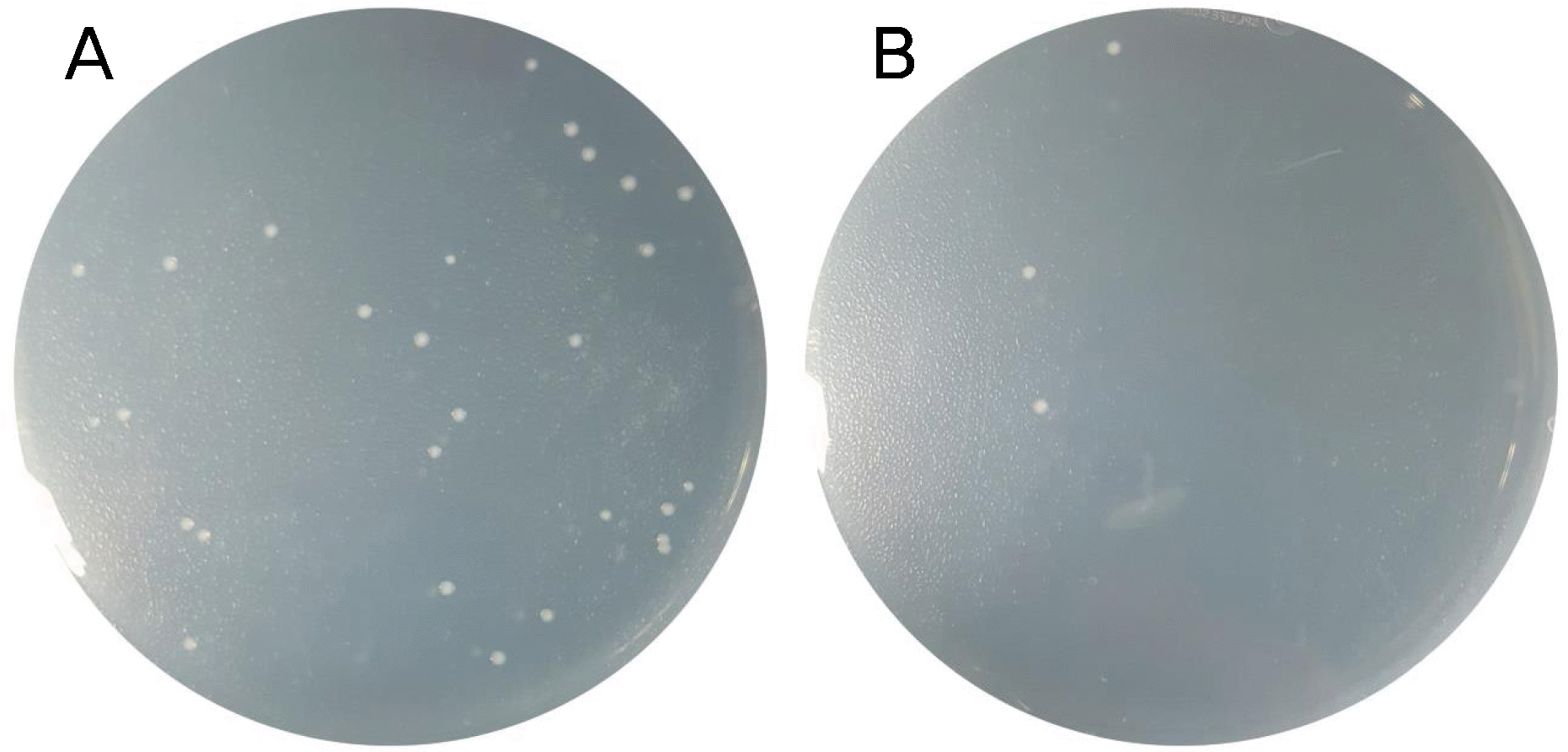 | Figure 1.Representative photographs of bacterial colonies on Luria-Bertani agar plate. The number of Pseudomonas aeruginosa colonies was significantly reduced in 5% contact lens (CL) storage cases containing 5% nephrite (B) compared with traditional CL storage cases (A). |
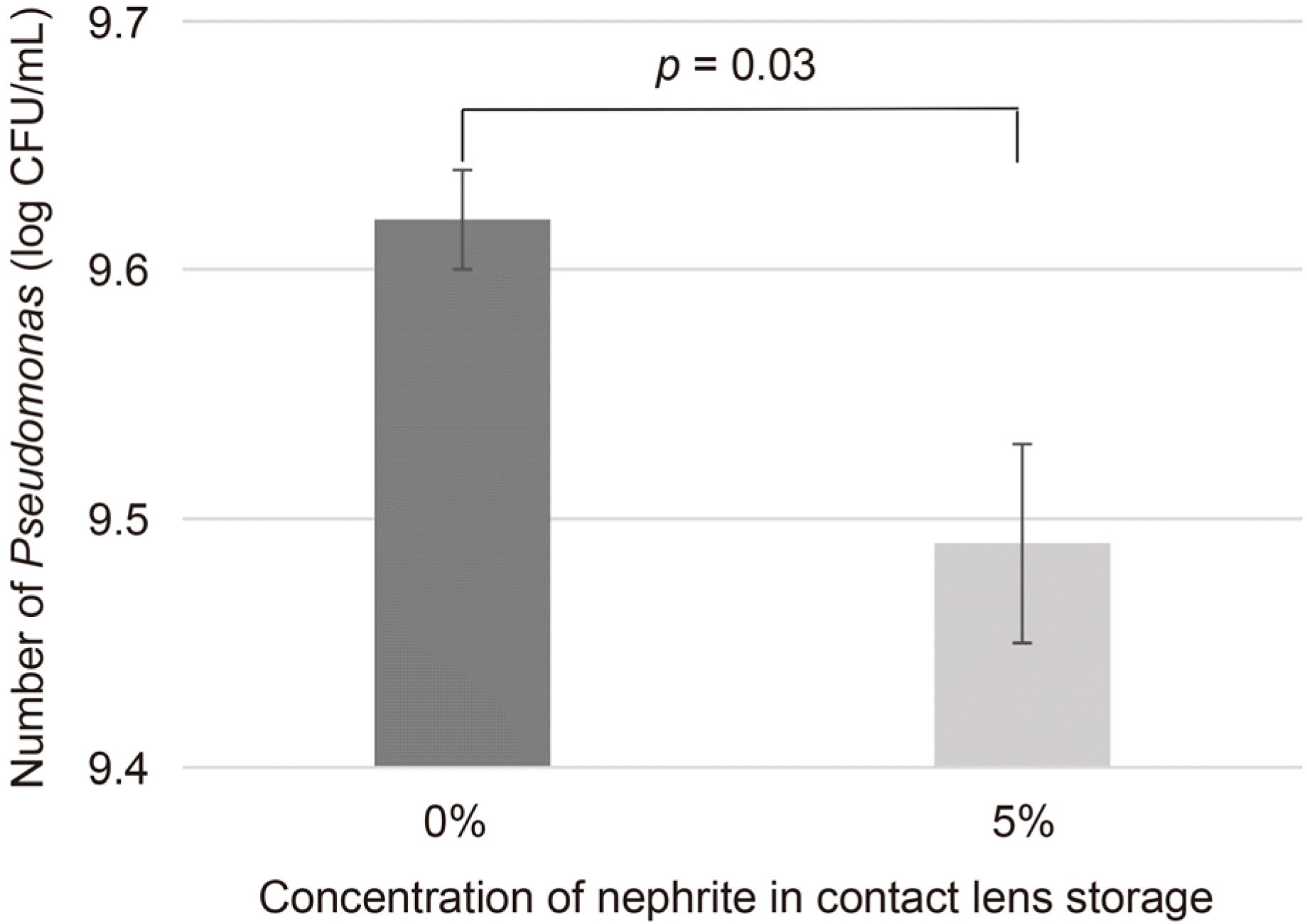 | Figure 2.Number of Pseudomonas aeruginosa (P. aeruginosa) on contact lens (CL) storage cases. CL storage cases containing 5% nephrite significantly reduced the numbers of P. aeruginosa compared with traditional CL storage cases. Using a unpaired t-test to compare the differences between the two groups. |
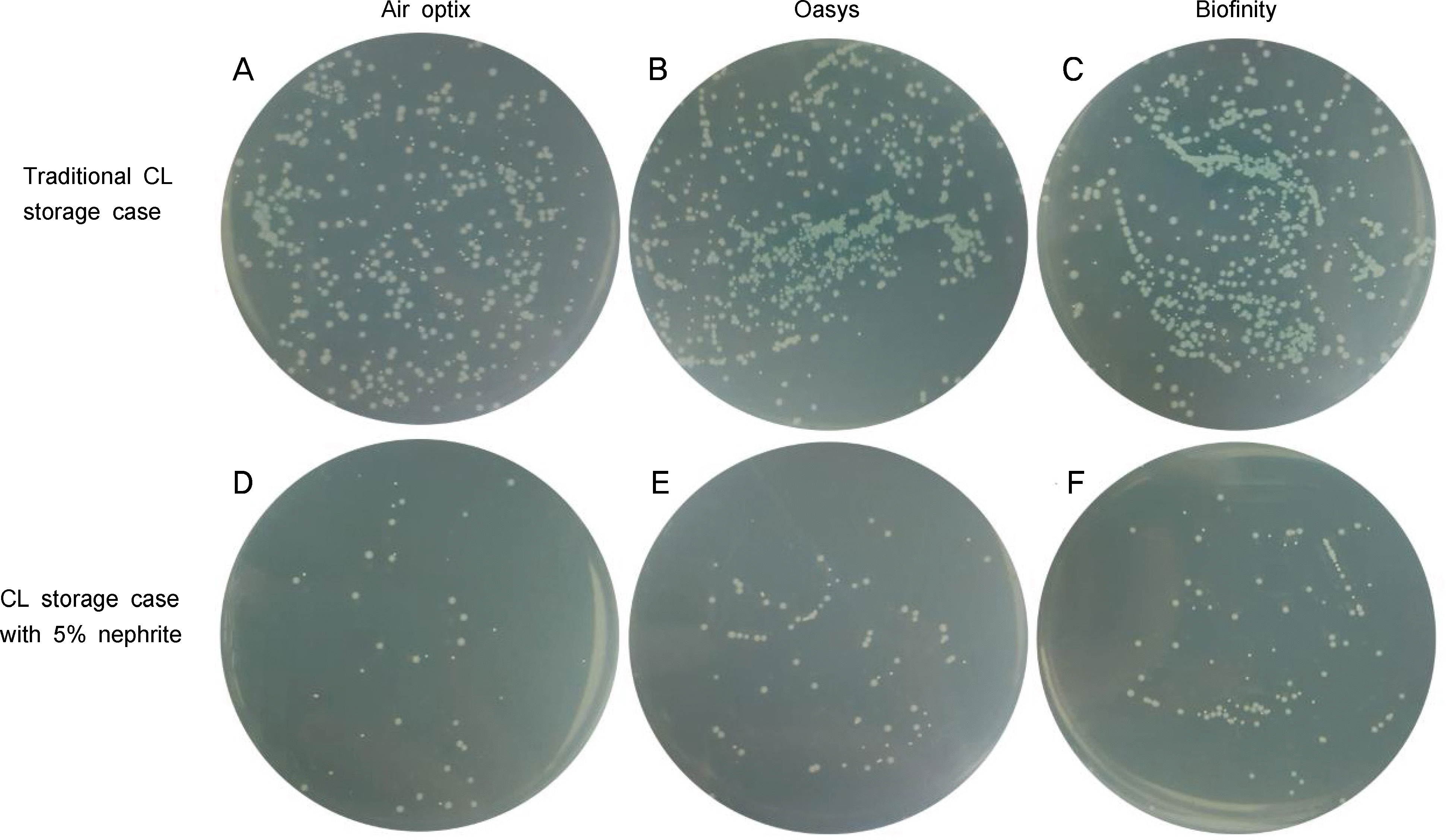 | FIgure 3.Representative photographs of bacterial colonies on Luria-Bertani agar plate. These pictures (A-F) show the decreased number of Pseudomonas aeruginosa colonies in all generations of silicone hydrogel contact lenses stored at contact lens (CL) storage cases containing 5% nephrite. |
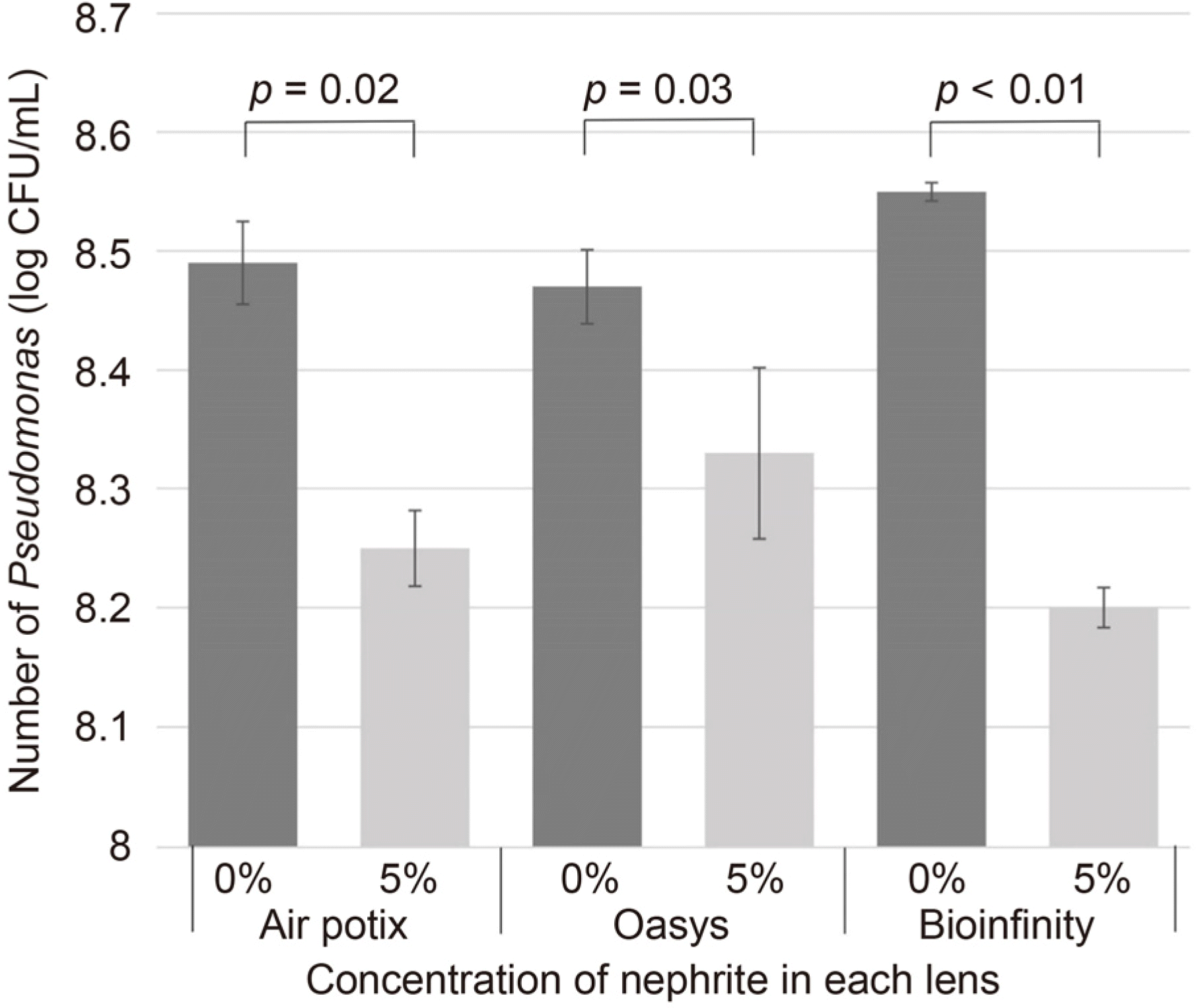 | Figure 4.The number of Pseudomonas aeruginosa (P. aeruginosa) adhering to contact lenses. The number of P. aeruginosa adhering to contact lenses in contact lens storage case containing 5% nephrite was significantly reduced compared with tra-ditional contact lens storage case regardless of the generation of silicone hydrogel contact lenses. Using a unpaired t-test to compare the differences between the two groups. |
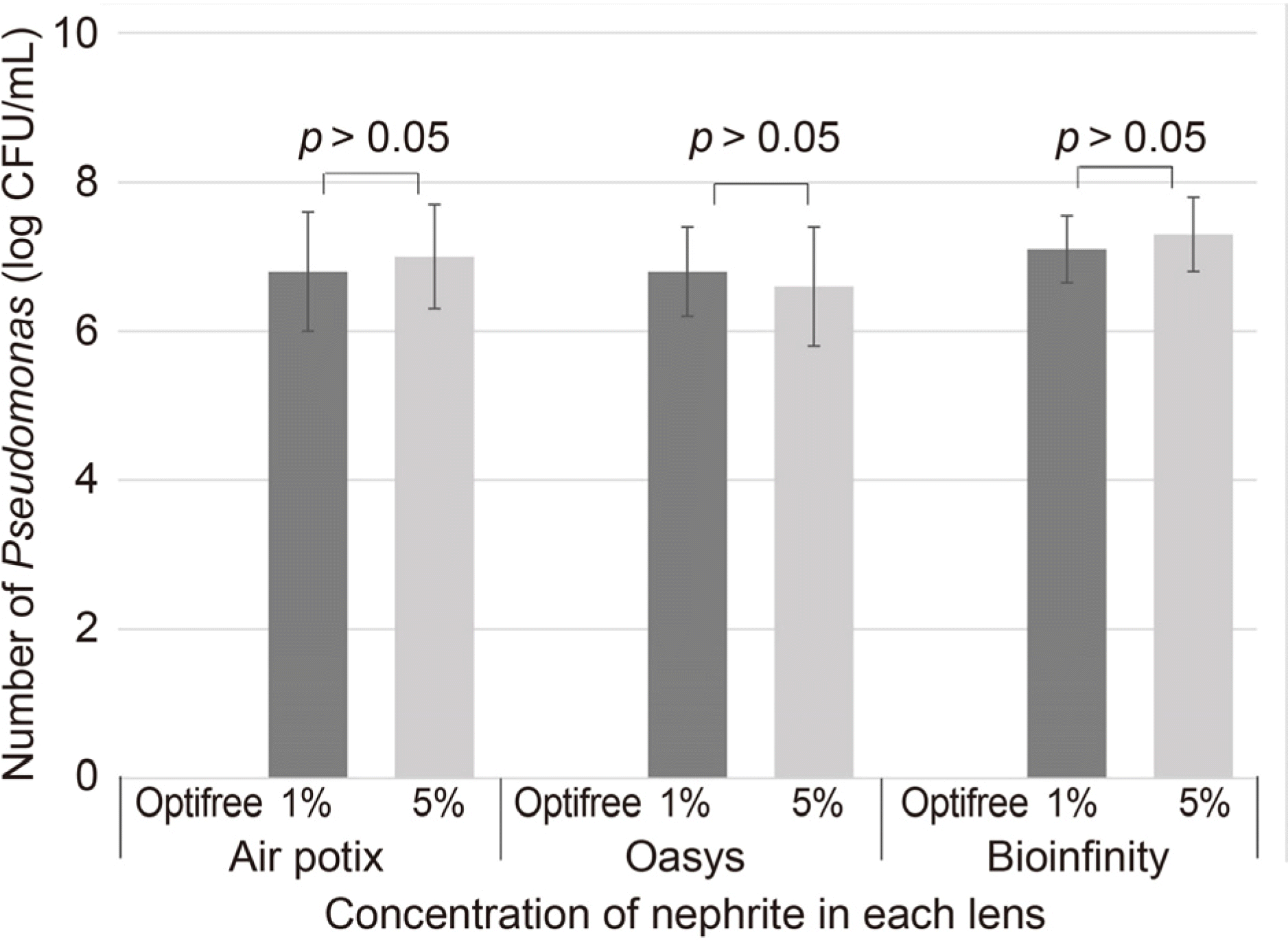 | Figure 5.Relationship of the number of Pseudomonas aeruginosa colonies among contact lenses treated with multipurpose solution and 1% and 5% nephrite solutions. Nephrite solutions showed a lot of colonies compared with optifree solution, regardless of the generation of silicone hydrogel contact lenses. Using a unpaired t-test to compare the differences between the two groups. |




 PDF
PDF ePub
ePub Citation
Citation Print
Print


 XML Download
XML Download